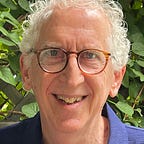A deep dive into audience metrics at KQED
By Andrew Lapin
I wasn’t sure what to expect when I walked into the first day of my Medill practicum with KQED, San Francisco’s public radio/TV station and the most-listened to NPR station in the country. But I had had a lot of experience working in the public broadcasting field, so I was excited to re-enter that space.
Almost immediately, I was given access to the Google Analytics page for the KQED website’s science content: a motherlode of data. I could see where the site’s visitors were coming from, what they clicked on once they were there, how long they stuck around and how they behaved when a story went “viral.”
Then my supervisors told me to make something out of all these numbers — to work with the Science team to design a dashboard for their most important metrics.
Being handed so much responsibility so quickly was intimidating, but I loved the pressure. My supervisors, Colleen Wilson and Carlos Gonzalez in the KQED Product team and Sue Ellen McCann in Science, didn’t want my limited time there to go to waste, so I focused on identifying the most useful insights for the Science team.
I made presentations to the Science team, outlining user trends I had noticed and helping steer them toward the most useful metrics for determining engagement (for instance, time on site and exit rates). Because public media is a mission-driven organization, its online operations have to be focused on user engagement, not just chasing clicks.
Although my time at KQED was originally centered on the Science dashboard project, I got pulled into another, even more influential assignment midway through my practicum. KQED’s coverage of the October fires that ravaged Northern California set an all-time weekly traffic record for the site, becoming the basis for NPR’s own coverage of the tragedy. The Product team asked me to explore the metrics to understand how the site’s visitors behaved during that week.
Were they more likely to seek out urgent information from Facebook, Google or elsewhere? What kind of information were they looking to KQED to provide? Did they want breaking news, or stories that provided some value-added public service for the fire’s victims? Or did they just want to read about celebrity chef Guy Fieri bringing a BBQ smoker to a fire shelter?
I used the assignment as an opportunity to apply what I’d been learning about media innovation in class to a much larger canvas. I learned how to use Google Data Studio to visualize my findings to present to KQED’s top news editors, who drilled me with questions about the site performance. I gave the same presentation to business staff later, and my findings (with a summary and “top 10 takeaways” post I prepared) were ultimately provided to the station president and other executives.
It might seem that KQED staff could review the analytics and draw conclusions themselves, but the news and content staff is constantly swamped in the day-to-day grind of churning out stories (just like the news staff in every organization). So it’s hard for them to find time to do this kind of exploration themselves. Their gratitude for my work spoke volumes about the importance of this kind of analysis in the modern news environment.
For media organizations to survive in the digital age, journalists have to learn more about their audience and the ways to reach them. Medill’s Media Innovation & Entrepreneurship program is engaged with these kinds of questions, via our coursework, practicums and site visits to organizations such as Google, Matter and NerdWallet. We’re all looking to the future, to the fires yet to come.
About the MSJ Media Innovation & Entrepreneurship Specialization:
Medill website | Video | Sign up for Medill Media Innovation newsletter | Rich Gordon’s guest column (Entrepreneurial Journalism Educators Network)
